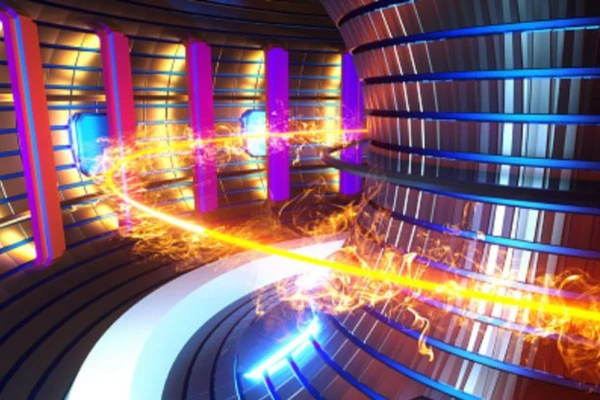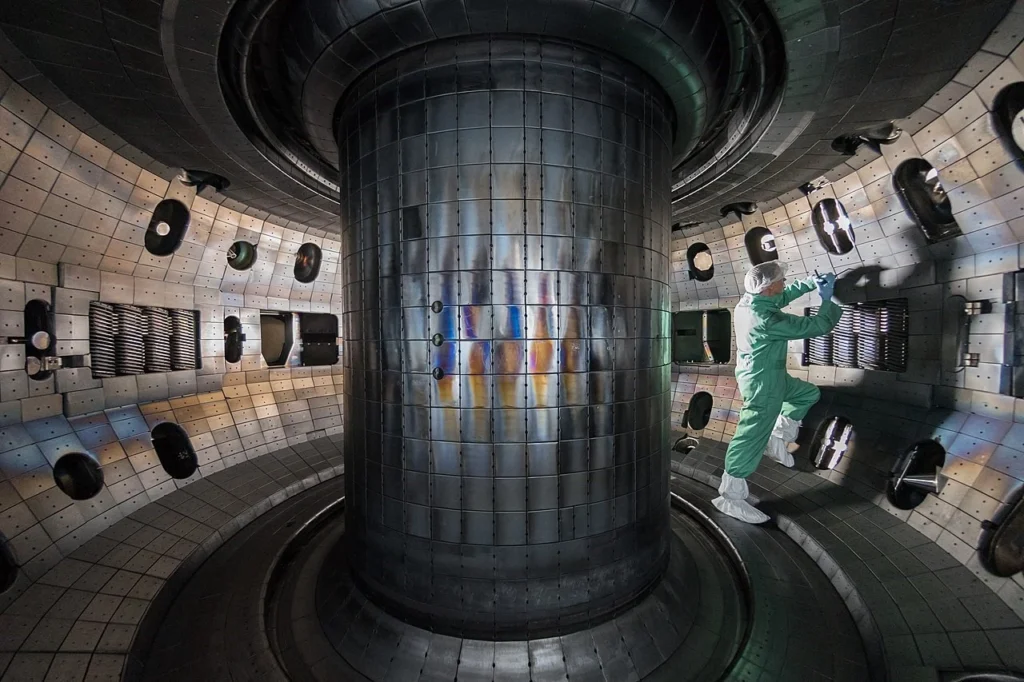South Korean scientists achieved a new world record with the Korea Superconducting Tokamak Advanced Research KSTAR device, a nuclear fusion reactor dubbed the “artificial Sun.”
About the achievement:
- Tokamak Advanced Research (KSTAR) device sustained plasma temperatures of 100 million degrees Celsius for 48 seconds during tests conducted,
- This temperature is seven times that of the Sun’s core, which is 15 million degrees Celsius.
- KSTAR also maintained the high confinement mode (H-mode) for over 100 seconds.
- H-mode is a stable plasma state.
- Maintaining high temperature and density in the plasma is crucial for sustaining fusion reactions over extended periods, making it essential for the future of nuclear fusion reactors.
About Nuclear fusion:
- Nuclear fusion seeks to replicate the reaction that makes the sun and other stars shine.
- It is a nuclear reaction that occurs when two or more light atomic nuclei combine to form a single heavier nucleus.
- In this reaction, two atoms of hydrogen or helium come together and fuse to unleash huge amounts of energy.
- Fusion has the potential to provide limitless energy without planet-warming carbon pollution.
- Nuclear fusion is the opposite of nuclear fission, which is when heavy elements diffuse and form lighter elements.
What is tokamak?
- Scientists generally use a donut-shaped reactor called a tokamak in which hydrogen variants are heated to extraordinarily high temperatures to create a plasma.
- High temperatures and high-density plasmas are vital for the future of nuclear fusion reactors.
- This is called the artificial Sun because it replicates the reaction of fusion taking place there and unleashes a massive amount of heat energy.
Significance of Nuclear Fusion:
- Nuclear fusion is considered to be one of the most environmentally friendly sources of energy.
- It doesn’t produce any long-lived radioactive nuclear waste.
- If nuclear fusion can be replicated on Earth at an industrial scale, it could provide virtually limitless clean, safe, sustainable and affordable energy.
- The only by-products of fusion reactions are small amounts of helium, an inert gas which can be safely released without harming the environment.
- Fusion reactions release approximately four million times more energy than burning coal, oil, or gas.
- Fuel for fusion is inexpensive and abundant in nature.
Challenges in achieving nuclear fusion:
- Extreme temperatures: Fusion is possible at temperatures of a few hundred million degrees Celsius, but creating these temperatures is difficult.
- Tolerant materials: The materials that make up the reactor need to be able to withstand these high temperatures, which can make building the reactor complicated.
- Plasma control: At these high temperatures, matter exists only in the plasma state, which expands very fast and is difficult to handle.
- Electromagnetic force: To fuse to elements, you need to break bypass the electromagnetic force. For example, hydrogen fuses at 3 million degrees Celsius in a star, but on Earth it would need to be heated to 150 million degrees Celsius.
- Fuel: The fuel for nuclear fusion is hydrogen at high temperatures, which can be hard to handle.
About Korea Superconducting Tokamak Advanced Research (KSTAR):
- KSTAR is one of the first research tokamaks in the world to feature fully superconducting magnets, which again will be of great relevance to ITER as this will also use superconducting magnets.
- ITER (International Thermonuclear Experimental Reactor) is an international nuclear fusion research and engineering megaproject aimed at creating energy through a fusion process similar to that of the Sun.
Ref:Source
| UPSC IAS Preparation Resources | |
| Current Affairs Analysis | Topperspedia |
| GS Shots | Simply Explained |
| Daily Flash Cards | Daily Quiz |



